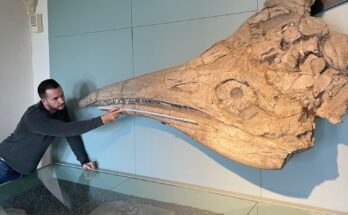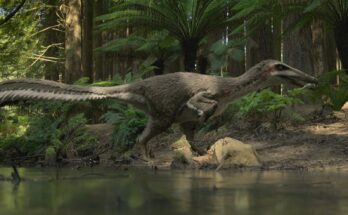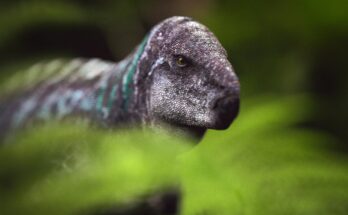✅ Part 1: Introduction – The Real vs. Movie Monster
In the opening scenes of Jurassic Park, a small, snake-like dinosaur with bright colors, a frill around its neck, and the ability to spit venom leaps from the shadows and takes down a villain. That dinosaur is introduced as Dilophosaurus — a name that instantly became famous around the world.
But here’s the thing: the real Dilophosaurus was very different from the Hollywood version.
In reality, Dilophosaurus was:
- Much larger than shown in the movie — about 7 meters (23 feet) long!
- Had no neck frill
- Didn’t spit venom
- And it wasn’t the size of a dog — it was the size of a small car!
Still, the movie helped make Dilophosaurus one of the most recognizable dinosaurs today. But the true story is even better. It was one of the earliest large theropod dinosaurs, living during the Early Jurassic period, about 193 million years ago. With its twin crests on its head, long slender body, and sharp teeth, Dilophosaurus was a fast, agile predator, perfectly designed for survival in a changing world.
It holds a special place in paleontology — not just as a predator, but as a key link between earlier primitive theropods and the later, more famous meat-eaters like Allosaurus and Tyrannosaurus rex. Understanding Dilophosaurus helps us understand how dinosaurs evolved, adapted, and came to dominate the planet.
In this article, we’ll dive into everything about this legendary dinosaur — from its discovery in the Arizona desert to the truth behind its double crest, its behavior, and how it has been portrayed in books, museums, and films. We’ll separate fact from fiction, and uncover the real-life story of this incredible animal.
Let’s begin with how the first bones of this ancient creature were discovered and how scientists slowly pieced together its true identity.

🦴 Part 2: The Discovery of Dilophosaurus – From Fossil to Fame
The story of Dilophosaurus begins in the hot, dry landscapes of the American Southwest, where ancient rocks hold the secrets of some of the earliest dinosaurs to walk the Earth. Long before it appeared on movie screens, Dilophosaurus was already turning heads — not with venom or frills, but with its mysterious double crest and early position in dinosaur evolution.
🧭 Discovery in the Arizona Desert
In 1942, a Navajo man named Jesse Williams discovered some strange fossilized bones near Tuba City, Arizona, on Navajo Nation land. The bones looked large and ancient, and he reported the find to paleontologists. The fossil came from rocks in the Kayenta Formation, a geologic layer known to date back to the Early Jurassic, about 193 million years ago.
Later, a team from the University of California, Berkeley, led by paleontologist Sam Welles, came to investigate. They carefully unearthed the skeleton of a large, bipedal dinosaur. At first, Welles didn’t notice anything too unusual — the creature appeared to be an early carnivore, and he gave it a temporary name: Megalosaurus wetherilli.
But that would soon change.

🧠 A Second Look — And a New Name
Several years later, in 1954, Welles revisited the fossil and made an important discovery: this dinosaur had two thin, curved crests on the top of its skull, like bony ridges running over its eyes and nose. This feature was completely unique. No other known dinosaur had such a structure at the time.
Because of these crests, Welles renamed the dinosaur Dilophosaurus wetherilli, which means:
“Two-Crested Lizard”
(Di = two, lophos = crest, saurus = lizard)
The species name wetherilli was kept to honor John Wetherill, a guide and explorer who helped early scientists study the Southwest.
With this new name, Dilophosaurus began to stand out — not just as a large, early predator, but as a dinosaur with an unusual and mysterious look.
📜 What the Early Fossils Revealed
The first complete skeleton of Dilophosaurus showed:
- It was about 7 meters (23 feet) long — larger than scientists expected for a dinosaur of that time.
- It had long legs and a slender build, suggesting it was fast and agile.
- Its arms were strong, with three-fingered hands and sharp claws.
- Its head was long and narrow, with thin bones and a noticeable notch in the upper jaw.
The most puzzling feature was, of course, the double crest. These were thin, fragile bones — too weak to be used in fighting, so scientists guessed they were likely used for display, maybe to attract mates or signal other members of its species.
🦖 More Discoveries
Since the 1940s, additional Dilophosaurus fossils have been found in:
- Arizona, USA — several partial skeletons
- China and India — related species from the same family
- South Africa — where similar early theropods help scientists compare and understand evolutionary patterns
Each new discovery helped fill in the puzzle of how Dilophosaurus lived, hunted, and evolved into more advanced predators later in the Jurassic period.
🏛️ Where to See Dilophosaurus Today
You can see real and replica Dilophosaurus skeletons in several museums, including:
- Museum of Northern Arizona (Flagstaff, AZ)
- Natural History Museum of Los Angeles County
- Smithsonian National Museum of Natural History (replicas)
- Dinosaur National Monument (Utah/Colorado)
These museums help showcase the real Dilophosaurus — not the Hollywood version — and share its importance as one of the first large meat-eating dinosaurs.
🧩 Summary of Its Discovery
| Year | Event |
|---|---|
| 1942 | First bones found in Arizona by Jesse Williams |
| 1942–1944 | Sam Welles identifies the fossil as an early carnivorous dinosaur |
| 1954 | Renamed Dilophosaurus wetherilli after crests were discovered |
| 1970s–2000s | More fossils found, adding to our understanding of its size, features, and role in the ecosystem |
| Today | Dilophosaurus is recognized as one of the earliest large theropods and a key species in dinosaur evolution |
Dilophosaurus’s discovery helped paint a clearer picture of the Early Jurassic world — a time when dinosaurs were just beginning to dominate Earth. And with its slender body and elegant crests, it showed that predators could be both deadly and beautiful.

🦎 Part 3: What Dilophosaurus Really Looked Like – Separating Fact from Film
If you’ve seen Jurassic Park, you might remember Dilophosaurus as the small dinosaur with a colorful frill around its neck that spat venom at Dennis Nedry. It was creepy, dramatic, and unforgettable — but it was also almost completely wrong.
In truth, the real Dilophosaurus was far more impressive, even without movie magic. It was a sleek, fast, and elegant predator, and one of the largest carnivorous dinosaurs of its time. In this section, we’ll look at what Dilophosaurus really looked like, how it moved, and why the movie version took so many liberties.
🎥 Movie Myths vs. Scientific Facts
Let’s start by busting a few myths created by the movies.
| Feature | Movie Version | Real Dilophosaurus |
|---|---|---|
| Size | Small – like a large dog (around 4 feet long) | Large – over 7 meters (23 feet) long |
| Frill | Had a frill that opened around the neck | No frill at all – this was invented |
| Venom | Spat poison at enemies | No evidence of venom-spitting |
| Sound | Made high-pitched hisses and growls | We don’t know for sure, but likely sounded more bird-like or reptilian |
The Jurassic Park creators admitted that they made Dilophosaurus smaller so it wouldn’t overshadow Velociraptors. They also added the frill and venom to make it more exciting for the audience. In reality, no fossil evidence has ever shown that Dilophosaurus could spit venom or had any kind of frill.
📏 Size and Shape
Real Dilophosaurus was a large and slender dinosaur. It measured up to:
- 7 meters (23 feet) long
- About 1.8 meters (6 feet) tall at the hip
- Weighed approximately 400–500 kg (880–1,100 lbs)
It had a long tail for balance and long, strong legs designed for running quickly.
🧠 Skull and Crests
One of Dilophosaurus’s most unique features was its twin crests. These two thin, semi-circular bones rose up from the top of its head and ran along the skull, like a double mohawk made of bone.
The crests were:
- Lightweight and hollow
- Likely not used for combat (too fragile)
- Probably used for display, like attracting mates or identifying other members of its species
Some scientists believe they may have even been brightly colored, like a bird’s feathers, though there is no direct fossil evidence for color.
Its jaw was long and slender, with a noticeable notch in the upper jaw just before the teeth — a feature that made early scientists unsure about what it ate or how strong its bite was.
🦴 Teeth and Diet
Dilophosaurus had sharp, curved teeth designed to cut through flesh. Its teeth were:
- Long and blade-like
- Serrated, like a steak knife
- Perfect for gripping slippery prey
Though its jaw bones were a bit fragile, its bite was still strong enough to kill smaller dinosaurs and reptiles. Some scientists suggest it may have used its claws to hold down prey while delivering deadly bites.
🐾 Arms, Hands, and Feet
Dilophosaurus had:
- Long arms with three-fingered hands
- Sharp claws for grabbing or slashing prey
- Strong hind legs for fast running
- Three-toed feet with long toes and claws — not built for speed like modern cheetahs, but for quick bursts of motion
It walked on two legs, like most theropods, with its body balanced horizontally and its tail stretched out behind.
🎨 Did It Have Feathers?
Right now, no direct feather fossils have been found with Dilophosaurus. However, since it was a theropod (the same group that includes birds), some scientists believe it may have had primitive feathers or feather-like structures, especially when young.
So far:
- There’s no proof of feathers
- But it’s possible, based on its evolutionary relatives
If it did have feathers, they may have been used for display, insulation, or attracting mates — similar to how birds use them today.
🦖 How Did It Move?
Dilophosaurus was built for speed and agility. With its light frame, long legs, and strong tail, it could likely:
- Run at fast speeds over short distances
- Use sudden bursts of motion to surprise prey
- Turn quickly to chase or dodge
Its slim body helped it move easily through forests and open plains — the perfect early Jurassic predator.
📸 Summary: Real Dilophosaurus at a Glance
| Feature | Description |
|---|---|
| Length | Up to 7 meters (23 feet) |
| Weight | 400–500 kg (880–1,100 lbs) |
| Crests | Two thin, bony ridges on the top of the skull |
| Arms/Hands | Three-fingered with sharp claws |
| Diet | Carnivorous – ate smaller dinosaurs and reptiles |
| Speed | Likely fast and agile |
| Frill/Venom? | No — that’s movie fiction |
The real Dilophosaurus didn’t need poison or frills to be scary. It was a fast, smart predator — one of the earliest big meat-eating dinosaurs, and a sign of what was to come in the Jurassic world.



